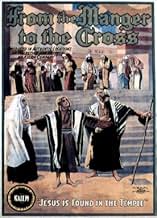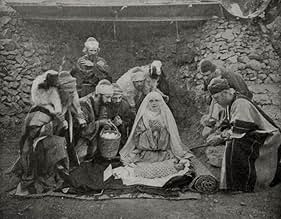Agrega una trama en tu idiomaAn account of the life of Jesus Christ according to the New Testament, told as a series of tableaus interspersed with Bible verses.An account of the life of Jesus Christ according to the New Testament, told as a series of tableaus interspersed with Bible verses.An account of the life of Jesus Christ according to the New Testament, told as a series of tableaus interspersed with Bible verses.
- Premios
- 1 premio ganado en total
R. Henderson Bland
- Jesus - the Man
- (as Robert Henderson-Bland)
Sidney Baber
- Thaddeus
- (sin créditos)
G. Howard Barton
- Wise Man 3
- (sin créditos)
F.T. Bostock
- Second Thief
- (sin créditos)
Frederic Bryson
- St. John
- (sin créditos)
J.J. Clark
- John
- (sin créditos)
Ralph T. Duncan
- Simon
- (sin créditos)
Lydia Gardebeau
- Salomé
- (sin créditos)
Frank T. Gregory
- St. Andrew
- (sin créditos)
Denton Harcourt
- St. Matthew
- (sin créditos)
- Dirección
- Guionista
- Todo el elenco y el equipo
- Producción, taquilla y más en IMDbPro
Argumento
¿Sabías que…?
- TriviaIronically, R. Henderson Bland was selected for the role of Jesus in a silent film because star/director Sidney Olcott liked the way his voice sounded on the telephone.
- ErroresJesus is shown healing Bartimaeus from his blindness but the verse used was Matthew 20:34 where he heals 2 blind men instead of 1. Using the Mark or Luke passage would have made this scene accurate.
- Versiones alternativasThe Vitagraph Co. of America released a six reel re-edited version of the film after it acquired Kalem's properties in 1919.
- ConexionesFeatured in The Great Christmas Movies (1998)
Opinión destacada
Director Sidney Olcott did not have a stunning career. If anything it was mediocre at best. But on this effort he played above his head, perhaps not even realizing it. "From the Manger to the Cross" is a beautiful film, rich in substance and well acted as well.
The story is well known and Olcott details all of Christ's shining biblical moments in a series of scenes that overcomes many setbacks of the early 1910's. Of particular note is the way he uses a large cast to still convey the emotions present during a particular scene. Christ's admittance to his disciples that his days on earth are numbered come to mind here. On location shooting, no easy task for its day considering the entire thing was done in Egypt and Palestine, would definitely be another.
Even with these tools, the film may have fallen flat were it not for Robert Henderson-Bland's portrayal of Jesus. When the most crucial aspects of the Messiah's personality are the things he said, how can a silent film succeed in showing his substance? Answer: facial expressions and body language. And Bland, without the as yet invented close-up, shines in showing Christ as a man of wisdom, gentleness, and courage. Bland's Jesus is still among the finest to ever grace a screen and we're closing in on a century of film following it. Robert Vignola's Judas also deserves a mention as well.
It also bares mentioning that Timothy Howard's organ score, added in 1994 upon the film's home release, is a beautiful addition. In 1998 "From the Manger to the Cross" was given the highest honor a film can receive: it was added to the National Film Registry, an accolade it well deserves. For now and all time it should be recognized not only as America's first feature film but as a testament to what can be accomplished in the name of art and love when all of the pieces fall into the right place at the right time. Olcott and Henderson-Bland forever have a much deserved home in film history's hall of fame.
The nutshell: required viewing for directing, acting, technological achievement, and artistic beauty...8/10.
The story is well known and Olcott details all of Christ's shining biblical moments in a series of scenes that overcomes many setbacks of the early 1910's. Of particular note is the way he uses a large cast to still convey the emotions present during a particular scene. Christ's admittance to his disciples that his days on earth are numbered come to mind here. On location shooting, no easy task for its day considering the entire thing was done in Egypt and Palestine, would definitely be another.
Even with these tools, the film may have fallen flat were it not for Robert Henderson-Bland's portrayal of Jesus. When the most crucial aspects of the Messiah's personality are the things he said, how can a silent film succeed in showing his substance? Answer: facial expressions and body language. And Bland, without the as yet invented close-up, shines in showing Christ as a man of wisdom, gentleness, and courage. Bland's Jesus is still among the finest to ever grace a screen and we're closing in on a century of film following it. Robert Vignola's Judas also deserves a mention as well.
It also bares mentioning that Timothy Howard's organ score, added in 1994 upon the film's home release, is a beautiful addition. In 1998 "From the Manger to the Cross" was given the highest honor a film can receive: it was added to the National Film Registry, an accolade it well deserves. For now and all time it should be recognized not only as America's first feature film but as a testament to what can be accomplished in the name of art and love when all of the pieces fall into the right place at the right time. Olcott and Henderson-Bland forever have a much deserved home in film history's hall of fame.
The nutshell: required viewing for directing, acting, technological achievement, and artistic beauty...8/10.
- Auburn668
- 8 feb 2004
- Enlace permanente
Selecciones populares
Inicia sesión para calificar y agrega a la lista de videos para obtener recomendaciones personalizadas
Detalles
- Tiempo de ejecución1 hora
- Color
- Mezcla de sonido
- Relación de aspecto
- 1.33 : 1
Contribuir a esta página
Sugiere una edición o agrega el contenido que falta

Principales brechas de datos
By what name was From the Manger to the Cross (1912) officially released in Canada in English?
Responda



























